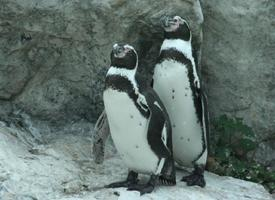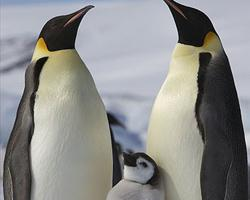
Poids et mesures
| Hauteur au garrot | 68 cm |
|---|---|
| Poids | 4,5 kg |
Description de l'animal
The Chinstrap Penguin (Pygoscelis antarcticus) is a striking and easily recognizable bird species native to the icy waters and rugged islands of the Southern Ocean and Antarctica. Characterized by the narrow black band under its head which gives the appearance of a helmet strap, this distinctive feature is the origin of its common name. This medium-sized penguin stands out against the stark white and blue backdrop of its natural habitat, making it a fascinating subject of study and observation.Adult Chinstrap Penguins typically reach a height of about 68 to 76 cm (27 to 30 inches) and weigh between 3 to 5 kg (6.6 to 11 pounds), with males generally being slightly larger than females. Their bodies are streamlined for efficient swimming, with powerful flippers and a tapered shape that allows them to navigate through the water with grace and agility. Their black back and white belly, a form of counter-shading, helps protect them from predators both above and below the water by camouflaging them against the ocean depths and the bright surface light.
These birds are highly social creatures, forming large colonies on ice-free slopes and coasts where they breed and rear their young. During the breeding season, which starts in November and December, Chinstrap Penguins return to the same nesting sites annually, where they build nests from stones. Mating pairs are monogamous throughout the breeding season, with both parents sharing the responsibilities of incubating the eggs and feeding the chicks. The diet of Chinstrap Penguins primarily consists of krill, though they also consume fish and squid. They are known to dive to depths of up to 70 meters (230 feet) in search of food, though most of their foraging occurs at shallower depths.
The life in these colonies is not without its challenges. Predation by seals, skuas, and other birds poses a constant threat to the eggs and the young. Additionally, the harsh and unpredictable Antarctic environment tests the resilience of these hardy creatures. Despite these challenges, Chinstrap Penguins have adapted well to their environment, with their population numbers being quite robust, though climate change and human activities pose new threats to their habitat and food sources.
Chinstrap Penguins are migratory, spending the winter months dispersed at sea, ranging from the Antarctic ice edge to more northerly subantarctic regions. This migration is a testament to their incredible endurance and adaptability, enduring some of the most extreme conditions on Earth.
In conclusion, the Chinstrap Penguin is a remarkable bird, emblematic of the Antarctic's unique biodiversity. Its distinctive appearance, fascinating social behavior, and the challenges it faces in its icy habitat make it a subject of great interest not only to scientists and conservationists but also to anyone intrigued by the natural world's wonders. As climate change continues to impact the Antarctic environment, understanding and preserving the Chinstrap Penguin's habitat becomes increasingly important.
Animaux similaires
Nouvelles photos d'animaux
Top 10 des animaux
- Dolphin gull (Leucophaeus scoresbii)
- Diana monkey (Cercopithecus diana)
- Moustached guenon (Cercopithecus cephus)
- Galápagos tortoise (Geochelone nigra complex)
- Japanese macaque (Macaca fuscata)
- Russian tortoise (Testudo horsfieldii)
- Stone loach (Barbatula barbatula)
- Greek tortoise (Testudo graeca)
- Common flying dragon (Draco volans)
- Vendace (Coregonus albula)


